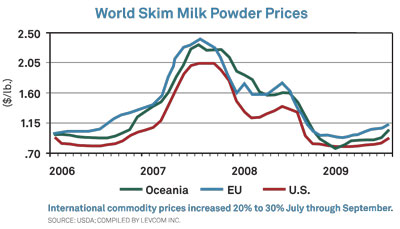Market Watch Diary Green shoots bring hope

Following a year of one dismal report after another, we're starting to see what the economists like to call the "green shoots” of a market recovery.
Let me temper that observation with a few words of caution. This recovery is likely to be uneven and won't give us gangbuster prices, at least not anytime soon. Don't expect $20 milk. But dare I say, the worst seems to be over.
First and foremost, milk supply is finally contracting. Milk production in July and August was down 0.2% from the prior year, and larger declines are coming. In June, July and August, cow numbers decreased by 109,000 head—a loss of 8,400 cows per week. Output in the western United States this summer ran about 3% below a year ago after decades of expansion.
Production growth has stalled in Europe and Oceania as well, and this hasn't escaped the notice of international buyers, who find themselves less comfortable carrying such shallow working inventories. Orders have picked up, though cautiously. International commodity prices climbed 20% to 30% across the board from the beginning of the third quarter to the quarter's end.
Significantly, the market strength both here and abroad has been broad-based. That is, cheese, butter, nonfat and whey are all firming at the same time, which hasn't happened since spring 2007. That's a good sign, since it suggests the rally may have some traction.
But again, don't get carried away. The patient has been gravely ill, and the recovery period will be lengthy. Support price levels and other government intervention mechanisms are highly uncertain. In addition, heavy inventories still hang over the world dairy market and will temper price rebounds going forward.
Europe has accumulated more than a billion pounds of milk powder and butter in government storage this year, while heavy stocks of cheese, butter and powder still hang over the U.S. market. The destocking process will take some time.
In short, we have reason to be encouraged. Dairy producers who survive this year's wreckage will find better profitability this winter and into next year. On top of recovering milk prices, the 2009 corn crop was large, and corn prices have fallen back to the $3 to $3.50 range.
That will make for a better 2010. Then, hopefully, the green shoots will sprout into something greater.
Bonus content:
More on powder prices
Fonterra defends milk powder auctions







